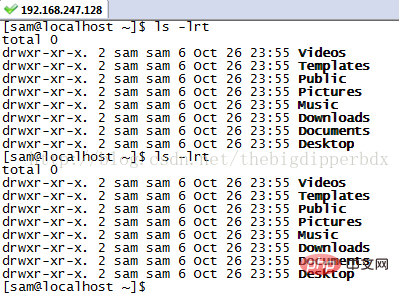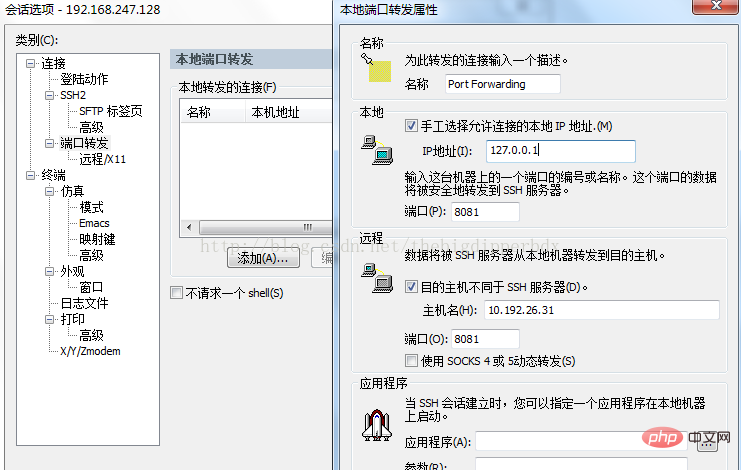SecureCRT is a terminal emulation program that supports SSH (SSH1 and SSH2). Simply put, it is a software for logging into UNIX or Linux server hosts under Windows. You can encrypt files by using the included VCP command line program. transmission.

A brief introduction to SecureCRT
SecureCRT is a software that supports SSH (SSH1 and SSH2) The terminal emulation program is simply a software for logging into a UNIX or Linux server host under Windows.
SecureCRT supports SSH, as well as Telnet and rlogin protocols. SecureCRT is an ideal tool for connecting to servers running Windows, UNIX and VMS. Encrypted file transfers can be performed using the included VCP command line program.
Has all the features of the popular CRTTelnet client, including: automatic registration, different features for different hosts, printing capabilities, color settings, variable screen size, user-defined keymaps and the excellent VT100, VT102, VT220 compete with ANSI.
Can be run from the command line or from the browser. Other features include text scripts, easy-to-use toolbars, user-friendly keymap editor, customizable ANSI colors, and more.
SecureCRT's SSH protocol supports DES, 3DES and RC4 passwords and password and RSA authentication.
SSH (Secure Shell Protocol) Introduction
SSH is the abbreviation of Secure Shell, developed by the Network Working Group of the IETF ;SSH is a security protocol based on the application layer. SSH is currently the most reliable protocol designed to provide security for remote login sessions and other network services. Using the SSH protocol can effectively prevent information leakage during remote management. SSH was originally a program on UNIX systems and quickly expanded to other operating platforms. SSH, when used correctly, can close holes in your network. SSH clients are available for a variety of platforms. Almost all UNIX platforms—including HP-UX, Linux, AIX, Solaris, Digital UNIX, Irix, and others—can run SSH.
Application in the project
Configuring local port forwarding in SecureCRT involves the local machine, springboard machine, and target server, because the local machine and The target server cannot be pinged directly, so port forwarding needs to be configured to forward the local request to the target server.
1. Log in to the springboard machine [192.168.247.128]

2. Configure local port forwarding
option ---> Session Options--->Port Forwarding-->Add--->Local Port Forwarding Properties--->Confirm

3. At this time, the The request for port 8081 of the local machine (127.0.0.1) is forwarded by the springboard machine (192.168.247.128) to the 8081 port of the target server (10.192.26.31)
4. During the forwarding process, SecureCRT (springboard machine) must be in Connection status, otherwise port forwarding will fail
The above is the detailed content of What is securecrt?. For more information, please follow other related articles on the PHP Chinese website!

Hot AI Tools

Undress AI Tool
Undress images for free

Undresser.AI Undress
AI-powered app for creating realistic nude photos

AI Clothes Remover
Online AI tool for removing clothes from photos.

Clothoff.io
AI clothes remover

Video Face Swap
Swap faces in any video effortlessly with our completely free AI face swap tool!

Hot Article

Hot Tools

Notepad++7.3.1
Easy-to-use and free code editor

SublimeText3 Chinese version
Chinese version, very easy to use

Zend Studio 13.0.1
Powerful PHP integrated development environment

Dreamweaver CS6
Visual web development tools

SublimeText3 Mac version
God-level code editing software (SublimeText3)
 How to Schedule Tasks on Linux with Cron and anacron
Aug 01, 2025 am 06:11 AM
How to Schedule Tasks on Linux with Cron and anacron
Aug 01, 2025 am 06:11 AM
cronisusedforpreciseschedulingonalways-onsystems,whileanacronensuresperiodictasksrunonsystemsthataren'tcontinuouslypowered,suchaslaptops;1.Usecronforexacttiming(e.g.,3AMdaily)viacrontab-ewithsyntaxMINHOURDOMMONDOWCOMMAND;2.Useanacronfordaily,weekly,o
 How to reset the TCP/IP stack in Windows
Aug 02, 2025 pm 01:25 PM
How to reset the TCP/IP stack in Windows
Aug 02, 2025 pm 01:25 PM
ToresolvenetworkconnectivityissuesinWindows,resettheTCP/IPstackbyfirstopeningCommandPromptasAdministrator,thenrunningthecommandnetshintipreset,andfinallyrestartingyourcomputertoapplychanges;ifissuespersist,optionallyrunnetshwinsockresetandrebootagain
 A guide to custom Windows installation options
Aug 01, 2025 am 04:48 AM
A guide to custom Windows installation options
Aug 01, 2025 am 04:48 AM
Choose"Custom:InstallWindowsonly(advanced)"forfullcontrol,asitallowsacleaninstallthatremovesoldissuesandoptimizesperformance.2.Duringsetup,managepartitionsbydeletingoldones(afterbackingupdata),creatingnewpartitions,formatting(usingNTFS),ors
 How to manage AppLocker policies in Windows
Aug 02, 2025 am 12:13 AM
How to manage AppLocker policies in Windows
Aug 02, 2025 am 12:13 AM
EnableAppLockerviaGroupPolicybyopeninggpedit.msc,navigatingtoApplicationControlPolicies,creatingdefaultrules,andconfiguringruletypes;2.Createcustomrulesusingpublisher,path,orhashconditions,preferringpublisherrulesforsecurityandflexibility;3.Testrules
 How to install software on Linux using the terminal?
Aug 02, 2025 pm 12:58 PM
How to install software on Linux using the terminal?
Aug 02, 2025 pm 12:58 PM
There are three main ways to install software on Linux: 1. Use a package manager, such as apt, dnf or pacman, and then execute the install command after updating the source, such as sudoaptininstallcurl; 2. For .deb or .rpm files, use dpkg or rpm commands to install, and repair dependencies when needed; 3. Use snap or flatpak to install applications across platforms, such as sudosnapinstall software name, which is suitable for users who are pursuing version updates. It is recommended to use the system's own package manager for better compatibility and performance.
 How to troubleshoot a failed Windows installation
Aug 02, 2025 pm 12:53 PM
How to troubleshoot a failed Windows installation
Aug 02, 2025 pm 12:53 PM
VerifytheWindowsISOisfromMicrosoftandrecreatethebootableUSBusingtheMediaCreationToolorRufuswithcorrectsettings;2.Ensurehardwaremeetsrequirements,testRAMandstoragehealth,anddisconnectunnecessaryperipherals;3.ConfirmBIOS/UEFIsettingsmatchtheinstallatio
 how to fix 'reboot and select proper boot device' on a win pc
Aug 01, 2025 am 05:20 AM
how to fix 'reboot and select proper boot device' on a win pc
Aug 01, 2025 am 05:20 AM
First,checkandcorrectthebootorderinBIOS/UEFItoensuretheWindowsdriveistheprimarybootdevice.2.VerifytheWindowsdriveisdetectedinBIOSunderstorageordrives.3.Ifnotdetected,troubleshoothardwareconnectionsbyreseatingSATAandpowercablesfordesktopsorreseatingth
 The Importance of Time Synchronization on Linux with NTP
Aug 01, 2025 am 06:00 AM
The Importance of Time Synchronization on Linux with NTP
Aug 01, 2025 am 06:00 AM
Timesynchronizationiscrucialforsystemreliabilityandsecuritybecauseinconsistenttimecauseslogconfusion,securityfailures,misfiredscheduledtasks,anddistributedsystemerrors;1.CheckNTPstatususingtimedatectlstatustoconfirmsynchronizationandserviceactivity;2





